 Have you ever had the “Aha” moment. When the light bulb goes off in your head. Mine happened at the Vatican over 29 years ago. We were on a tour and entered a hall lined with magnificent statuary.
Have you ever had the “Aha” moment. When the light bulb goes off in your head. Mine happened at the Vatican over 29 years ago. We were on a tour and entered a hall lined with magnificent statuary.
The guide informed us that the women’s statues had removable hair pieces that could be changed out as hair styles changed thru-out the years. The women wanted to be current and on trend and did not want their age disclosed because of an out-dated hairstyle. This got me thinking about all the jewelry I have observed in museums and what secrets they might hold. I started studying the historical and varying era’s of jewelry to unlock some of the trends and meanings of each period. I must admit I was always drawn to the jewelry exhibits in the great museums (yes and the Faberge egg ones too).
Cultural events most definitely impacted the direction of jewelry. Starting with the 18th century, we go through history’s most important periods of jewelry styles, their most popular pieces and motifs and the social, political, and economic climate that influenced the era’s jewelry designs.
For a piece of jewelry to be classified as an “antique,” it must be over 100 years old. How do you quantify and date a piece of your jewelry. Much like paintings, a style of jewelry can be used to date it back to a certain era.
Some of the most influential eras are: Georgian, Victorian, Edwardian, The Art Nouveau Era, The Art Deco Period, The Retro and the Modern Eras. There are prominent trends that can distinguish a piece within a particular century, and knowing the approximate time period that your jewelry is from can be a great advantage when it comes time to sell. The guide below describes the various jewelry eras in detail for some do-it-yourself research. You can also contact a Regal Estate jewelry expert by filling out the form below to receive an exact cash offer for your antique and estate jewelry pieces.
Call toll free: 1-866-475-5389
The Georgian Era (1714-1830)
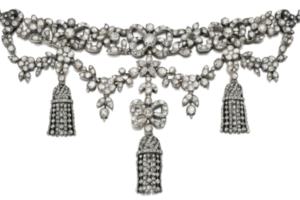 This era spanned four English Kings Named George-(thus the Georgian Era) and over 100 years. Marie Antoinette and Jane Austen lived during this period. Jewelry was expensive and the methods were much more basic. The casting of metals didn’t become established till after the Georgian period had ended. Stones were generally set in 18K gold and silver and constructed of thin sheet metal. Stones would typically be set in silver and backed in gold to prevent tarnishing. This was also done to enhance the light properties of the stones.
This era spanned four English Kings Named George-(thus the Georgian Era) and over 100 years. Marie Antoinette and Jane Austen lived during this period. Jewelry was expensive and the methods were much more basic. The casting of metals didn’t become established till after the Georgian period had ended. Stones were generally set in 18K gold and silver and constructed of thin sheet metal. Stones would typically be set in silver and backed in gold to prevent tarnishing. This was also done to enhance the light properties of the stones.
It was common for Georgian era jewelry to have one piece with stones of many different shapes and sizes, such as is important diamond devant de corsage (right) sold by Sotheby’s in December of 2012. In the early history of jewelry design the pieces were designed to fit the shape of the stones. Large and colorful gemstones were popular as well, including rubies, emeralds, topaz & amethyst. Diamonds were also favored, especially in larger pieces of jewelry. Many designs were inspired by nature, including birds and flowers. These pieces will generally have closed back settings, including foil backings. It is rare to find genuine Georgian-era pieces outside of a museum because of their age thus increasing their value.
The Victorian Era (1835-1901)
The Victorian period was named for the young and beautiful Queen Victoria of England. This era splits into three periods with each of these three stages correlating to the different periods of Victoria’s life.
- The Romantic Era: 1830-1848
- The Grand Victorian Era: 1848-1870
- The Aesthetic Period: 1870-1901
Queen Victoria inherited the throne of England at 21 years of age in 1837. The early Victorian era or Romantic Period was influence by a handful of different periods: Classical, Gothic, Renaissance and even Ancient Greek & Roman mythology were incorporated into jewelry design. One of the most famous styes from the romantic period is the cameo, made of carved shell or coral and formed into necklaces, lockets, bracelets and earrings.
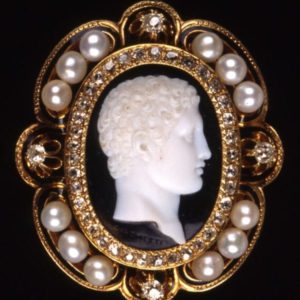 In the early 1800s, cameos carved from gemstones were seen as quite rare. Then conch shell cameos made an appearance and became very popular. These were carved by hand usually by Italian artisans and because shell was easier to carve then stone, shell cameos were more affordable and were easier to obtain. Take a look at this cameo pendant (left) which dates back to the late 18th or early 19th century. In a gold setting, it features the head of Hercules and is surrounded by diamonds and pearls. (from The British Museum)
In the early 1800s, cameos carved from gemstones were seen as quite rare. Then conch shell cameos made an appearance and became very popular. These were carved by hand usually by Italian artisans and because shell was easier to carve then stone, shell cameos were more affordable and were easier to obtain. Take a look at this cameo pendant (left) which dates back to the late 18th or early 19th century. In a gold setting, it features the head of Hercules and is surrounded by diamonds and pearls. (from The British Museum)
The union of Queen Victoria and Prince Albert in 1840, played a major part in shaping jewelry design during this time. Jewelry became more than just beautiful; it began to hold sentiment and symbolized love, romance, friendship and faith. Prince Albert gave Victoria a ring in the form of a serpent eating it’s own tail, a symbol of eternal love. This influence created jewelry with hearts, flowers, birds & bows. Enamel and colored gemstones became prevalent.
Hair combs and pins were an important part of a women’s wardrobe. They were made of gold, gemstones and enamel. “Acrostic” jewelry which featured rows of different gemstones so that their first letters spelled out secret words such as “dear” (diamond, emerald, amethyst, ruby) made their introduction during the Victorian period.
Revivalism was an aesthetic movement in the Grand Period that saw a renewed interest in Renaissance design and featured Greek and Roman motifs such as doves, peacocks and mosaic techniques. The other notable trend of this era symbolized the queen’s mourning of her late husband. Golden lockets and the use of black in jewelry became very normalized during this period. Jet onyx, black glass and black pearls were adopted into the jewelry. Human hair was also incorporated into designs, which was meant to be a sentimental tribute.
During the last Victorian Period, Victoria emerged from mourning, and whimsical designs reemerged. More gold mines were discovered on the American west coast and in Alaska and more diamond mines opened in S. Africa. The influx of new gold and diamonds lowered the cost of fine jewelry. In 1897 Diamond jewelry became exceedingly more popular when it was used to celebrate the Queen’s 60th anniversary. Inexpensive pieces of jewelry were made for the lower classes, that were cast in silver and stamped with a “V” for Victoria. It was during this era that solitaire diamond engagement rings gained popularity!
In the 19th century, matching jewelry sets (known as Parures) that included a complementary necklace, brooch, bracelet, set of earrings and often a tiara became the au courant look of the upper class. A variation is the “demi-parure” which consists of as few as two matching pieces, such as earrings and a necklace or brooch.
The Edwardian Era (1901-1910)
The Edwardian Era is considered the height of sophistication in style and society. This period is also known as La Belle Epoque Era. It follows the reign of England’s King Edward and was he was the last monarch to serve as a namesake in jewelry history.
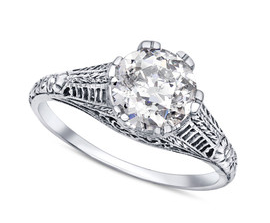 This was a time of renewed dominance of the upper class. An opulent jewelry staple gained popularity during this era: the use of platinum. It became popular because of its strength and allowed the development of more intricate and detailed pieces. Jewelry and art of this period were more elaborate and decorative with classic, feminine patterns and lacy filigree. Edwardian jewelry was light and delicate, with a heavy emphasis on showcasing brilliant diamonds.
This was a time of renewed dominance of the upper class. An opulent jewelry staple gained popularity during this era: the use of platinum. It became popular because of its strength and allowed the development of more intricate and detailed pieces. Jewelry and art of this period were more elaborate and decorative with classic, feminine patterns and lacy filigree. Edwardian jewelry was light and delicate, with a heavy emphasis on showcasing brilliant diamonds.
Colorful gemstones like emeralds, rubies and sapphires were also used, but diamonds were the real focal point. The most prominent motifs were bows, festooning ribbons, flowers and sporting events. The “white on white” look was a sophisticated departure, so many pieces were made with diamonds or pearls set in platinum or white gold.
The Art Nouveau Era (1895-1915)
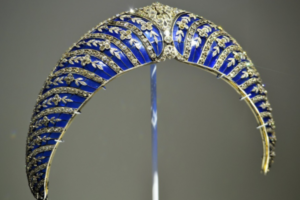 This is the era where design and craftsmanship were primarily valued. The Art Nouveau style was generated as a revolt against the industrial age’s technological advances. The jewelry of this era is some of the most desirable in the world. It is characterized by elegant, sweeping lines, designed to evoke the movement of water and clouds. Influenced by nature and Japanese art-leaves, flowers, birds and dragonflies as well as abstract depictions of the female form were prominent in the pieces of this era.
This is the era where design and craftsmanship were primarily valued. The Art Nouveau style was generated as a revolt against the industrial age’s technological advances. The jewelry of this era is some of the most desirable in the world. It is characterized by elegant, sweeping lines, designed to evoke the movement of water and clouds. Influenced by nature and Japanese art-leaves, flowers, birds and dragonflies as well as abstract depictions of the female form were prominent in the pieces of this era.
The Art Nouveau period overlapped the Edwardian Era and was a stark contrast to those pieces. These pieces were handcrafted and diamonds were used as an accent and not as a primary gemstone. The most important concept from this era was the use of enamel on jewelry. The palate was more muted with the use of opals, citrine, moonstone and amber. Jewelers became artists rather than craftsman because of the intricate designs.
The Art Deco Era (1915-1935)
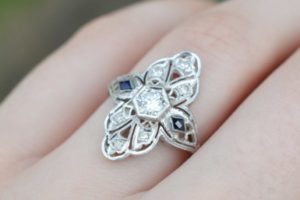 World War 1 was beginning during this era which meant that jewelry manufacturing came to a screeching halt and the trends of the Edwardian Era were no longer relevant. Women were expected to take on what had historically been men’s roles . There was a new wave of feminism that rejected conservatism and traditional femininity. Women donned baggy and bright tunic dresses paired with long jeweled necklaces, piles of bracelets and elaborate earrings. Art Deco practitioners were often paying homage to modernist influences such as Cubism, De Stijl and Futuris, while inventing a new style. Art Deco blended together glamour, luxury and the times immense technological advances. Influenced by the styles and taste of the Jazz Age, emeralds, rubies and sapphires, diamond engagement rings and elaborate metalwork were prominent in these pieces.
World War 1 was beginning during this era which meant that jewelry manufacturing came to a screeching halt and the trends of the Edwardian Era were no longer relevant. Women were expected to take on what had historically been men’s roles . There was a new wave of feminism that rejected conservatism and traditional femininity. Women donned baggy and bright tunic dresses paired with long jeweled necklaces, piles of bracelets and elaborate earrings. Art Deco practitioners were often paying homage to modernist influences such as Cubism, De Stijl and Futuris, while inventing a new style. Art Deco blended together glamour, luxury and the times immense technological advances. Influenced by the styles and taste of the Jazz Age, emeralds, rubies and sapphires, diamond engagement rings and elaborate metalwork were prominent in these pieces.

Art Deco emerald, sapphire and diamond brooch. (Gemolithos)
Retro or Retro Modern Era (1935-1950)
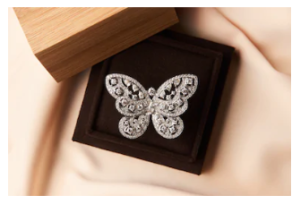 Retro jewelry refers to pieces created by a period during which jewelry designers were largely influenced by the changes accompanying World War II. As the name suggest, these designs reflect an infusion of futuristic vision along with elements inspired by preceding periods. Often the jewelry was designed to offset the somber and austere atmosphere caused by the war.
Retro jewelry refers to pieces created by a period during which jewelry designers were largely influenced by the changes accompanying World War II. As the name suggest, these designs reflect an infusion of futuristic vision along with elements inspired by preceding periods. Often the jewelry was designed to offset the somber and austere atmosphere caused by the war.
Jewelry had an American direction and style, with more rhinestones, crystal, lucite, wood and costume jewelry coming into play. Brooches with flowers, bows and butterflies were especially popular among women who relied on these feminine motifs to soften the era’s masculine clothing styles
The Retro Period was one of the most transitional as the world marched into the future. Retro bracelets, like other jewelry from the period, boldly reflect this transition. Many designs were based on the geometric styling of tank treads and assembly lines. Yellow gold and rose and green gold alloys were used a lot. This was a time of industrialization, with machines being used to cut gemstones for the first time. This led to the advent of the round brilliant-cut diamond, bringing into play for engagement rings.
Because of the war, platinum was scarce and jewelers turned to more budget-friendly stones like amethyst, aquamarine, citrine in lieu of expensive diamonds,sapphires and emeralds. Retro designs usually included large semi-precious stones and only a few precious stones. To achieve a rich look the settings were usually bold, geometric styles. Retro jewelry has a distinct air of old Hollywood glamour. Think of Lana Turner and Rita Hayworth. This period ushered in one of the most exciting developments in art and design worlds, a mood reflected in the innovative jewelry designs.
Modern Era (1950 +)
After World War II the age of Suburban Settlement occurred. It was a period where “neighborhoods” stabilization, family growth, television all became the norm. Automobile design, home design and jewelry design were innovative and impactful. Jewelry from this era reflected the economic growth in the United States. Pieces incorporated luxury, lots of flashy stones and many, many diamonds. This is the era where De Beers unveiled its slogan “Diamonds are Forever”. Unlike the Retro era, design focused on unique textures vs a more polished look. The movement was towards more eccentric design. It was the time of streamlined design, curves, futuristic impression and Modernism. Abstract, organic-shaped and richly textured yellow gold jewelry dotted with colorful gemstones became popular. Other popular materials were silver, brass and copper.
Per the times, just like the car industry, jewelry design was revolutionary and way ahead of it’s time. Abstract collars in brass, hanging mobile earrings and oversize cuffs ruled the day. This was the era of “more is more”.

 Knowing the history of jewelry enhances the pieces you own and may help guide you if you have pieces you would like to sell. Hopefully these descriptions of styles of the periods will increase your awareness. (a note regarding the dates of each era: they may be somewhat subjective as I explored the rich history of these periods the dates never appeared to align from book to book and article to article but all are close in time-frame)
Knowing the history of jewelry enhances the pieces you own and may help guide you if you have pieces you would like to sell. Hopefully these descriptions of styles of the periods will increase your awareness. (a note regarding the dates of each era: they may be somewhat subjective as I explored the rich history of these periods the dates never appeared to align from book to book and article to article but all are close in time-frame)
Travel tip: when in Paris visit Place Vendome to search for the same treasures our forebears lusted after: foil-backed emerald earrings, intaglio cameos and old mine-cut diamond jewelry. You can unearth some dazzling pieces from the past centuries!
Contact Regal Estate Jewelry to get a quote on the best price to sell a stone or piece of vintage jewelry thru their experienced Graduate Gemologist and GIA certified buyers and sellers of precious stones, diamonds and quality watches. It is the highly trained and qualified place to get a valuation on your jewels.
Call toll free: 1-866-475-5389

